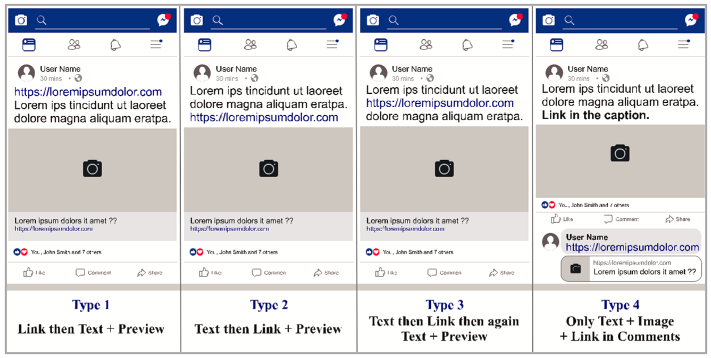Boost Your Social Media: Organic Facebook Posts
Yash Chawla, PhD and Prof. Grzegorz Chodak
 Social media is the fastest-growing advertising media class in the world. Forecasters predicted that the level of social media users would reach 3.09 billion in 2021, but one year ahead of predictions, in 2020, social media users far surpassed expectations, reaching a total of 4.2 billion. In October 2022, this number reached a staggering 4.72 billion, accounting for almost 60% of the world population. With the recent increase in social media usage, social media marketing has also increased exponentially. Firms have learned that this is an important venue in which to market to their audience, but they also need help with how to most effectively use this relatively new tool. Many firms have social media pages but need to create engagement with their posts. Firms and social media managers often turn to paid promotions to grapple with this issue, but there may be a better answer. In our study, we analyze the most effective way to post on Facebook in order to drive organic (non-paid) traffic and engagement for your social media account.
Social media is the fastest-growing advertising media class in the world. Forecasters predicted that the level of social media users would reach 3.09 billion in 2021, but one year ahead of predictions, in 2020, social media users far surpassed expectations, reaching a total of 4.2 billion. In October 2022, this number reached a staggering 4.72 billion, accounting for almost 60% of the world population. With the recent increase in social media usage, social media marketing has also increased exponentially. Firms have learned that this is an important venue in which to market to their audience, but they also need help with how to most effectively use this relatively new tool. Many firms have social media pages but need to create engagement with their posts. Firms and social media managers often turn to paid promotions to grapple with this issue, but there may be a better answer. In our study, we analyze the most effective way to post on Facebook in order to drive organic (non-paid) traffic and engagement for your social media account.
About our Study
Customer surveys account for a major part of social media marketing studies, and there needs to be more real-world empirical data that could provide holistic insights to the researchers, as well as practitioners. Our study, though, consists of an actual experiment on a real Facebook account using a controlled experimental design. We focused on “organic promotions,” which refers to the unpaid dissemination of marketing content via a Facebook business page. In this study, we have two specific questions we aimed to answer. First, what is the optimal time to post, and what gap in time between posts is most effective when promoting a product organically? Second, how are engagement and effectiveness of a post affected by the visual location of the web link in the post?
For our experiment, we partnered with a Polish e-commerce store that sells items such as books, games, and films. The Facebook page had 5,032 followers when we began the experiment. With the help of the e-commerce store owner, 24 books were chosen, and for each book, we used four different types of posts (see also Figure 1.):
- Type 1: Weblink, then text, and then preview image
- Type 2: Text, then weblink, and then preview image
- Type 3: Text, then weblink, more text, and then preview image
- Type 4: Text, preview image, and then weblink in the comments
Figure 1.1
Over four days, 96 posts were created and posted, with one hour between posts. Each post was then allowed ten days to accumulate engagement. After ten days, the number of reactions and clicks were observed.
Our Findings
Throughout our experiment, 101 units of product were sold, and the business gained 13 new followers. The campaign reached over 17,500 Facebook users and accounted for 664 reactions and 258 link clicks. Throughout the experiment, we found that post Type 4 (text and preview image, with the link in the comments) was the most effective. Type 4 accounted for approximately 45% of the reach, 48% of the reactions, and 62% of the link clicks. Through our research, it was clear that a post with a link in the comment section of the post was the most effective and reached more users. It also indicates that the Facebook algorithm is less friendly to posts with links in the caption. Our perspective on it, in hindsight, is that this is a strategy that is adopted to lure businesses for more paid promotions.
The time of the posting was also influential in the reach and engagement of a post. It is difficult to say that posting at one specific time is better than another. Through our study, we noticed the significance of the timing of the post; however, we emphasize that each business and industry is different, and firms must evaluate their own target audiences to learn what time of day is most effective in reaching followers.
Managerial Implications
Social media is an incredible tool that can be leveraged to grow business, particularly for those that have a business-to-customer (B2C) model. As marketing managers or specialists, you constantly look for ways to increase your reach to new customers and drive traffic to your website. Through our study, we recommend that when posting on your Facebook business page, instead of placing the web link in the caption, place it in the comments. Add an image or a video with a caption in the main posts. It will lead to more clicks and more visitors on your webpage.
Another key takeaway from our study is that firms must understand when their specific audience is most engaged. We recommend running an experiment on your own social media channels to better understand ideal times to increase engagement. With a better understanding of your target audience, you can cater your posts to your audience’s schedule to increase effectiveness of your marketing communications.
. . . . . . . . . . . . . . . . . . .
Recommended Reading
Chawla, Yash and Grzegorz Chodak (2021), “Social Media Marketing for Businesses: Organic Promotions of Web-Links on Facebook,” Journal of Business Research, 135, 49-65.
. . . . . . . . . . . . . . . . . . .
Reference
- Chawla, Yash and Grzegorz Chodak (2021), “Social Media Marketing for Businesses: Organic Promotions of Web-Links on Facebook,” Journal of Business Research, 135, 49-65.
. . . . . . . . . . . . . . . . . . .
About the Authors
Yash Chawla, PhD
Assistant Professor of Management Sciences, Wroc'?aw University of Science and Technology (Poland) and R&D Communications Advisor, DAC.digital (Poland)
Dr. Yash Chawla (PhD – Wroc'?aw University of Science and Technology) has a double Bachelor’s degree in Mechanical Engineering and Computer applications. Dr. Chawla then received a Masters of Business Administration and a Masters of Technology (Renewable Energy Technology). At Wroc'?aw Tech, he was named twice as the best young scientist (under 40) in Management and Quality discipline. Most of his research centers around social media, sustainable development, design thinking, economics, pedagogy, and economics and employability. Along with academia Dr. Chawla also serves in different consulting and training roles, currently serving as an R&D Communications Advisor at DAC.digital, as well as the Assistant Editor for a scientific journal, Operations Research and Decisions.
Grzegorz Chodak, PhD
Associate Professor of Management Sciences, Wroc'?aw University of Science and Technology (Poland)
Prof. Grzegorz Chodak (PhD and Habilitation – Wroc'?aw University of Science and Technology) currently serves as an Associate Professor at the Department of Operations Research and Business Intelligence, Wroc'?aw Tech, Poland. He has authored over 80 scientific publications, primarily in the field of electronic commerce, social media, data mining, and logistics. Prof. Chodak specializes in issues related to e-business, and he also has practical advisory experience in electronic commerce.
